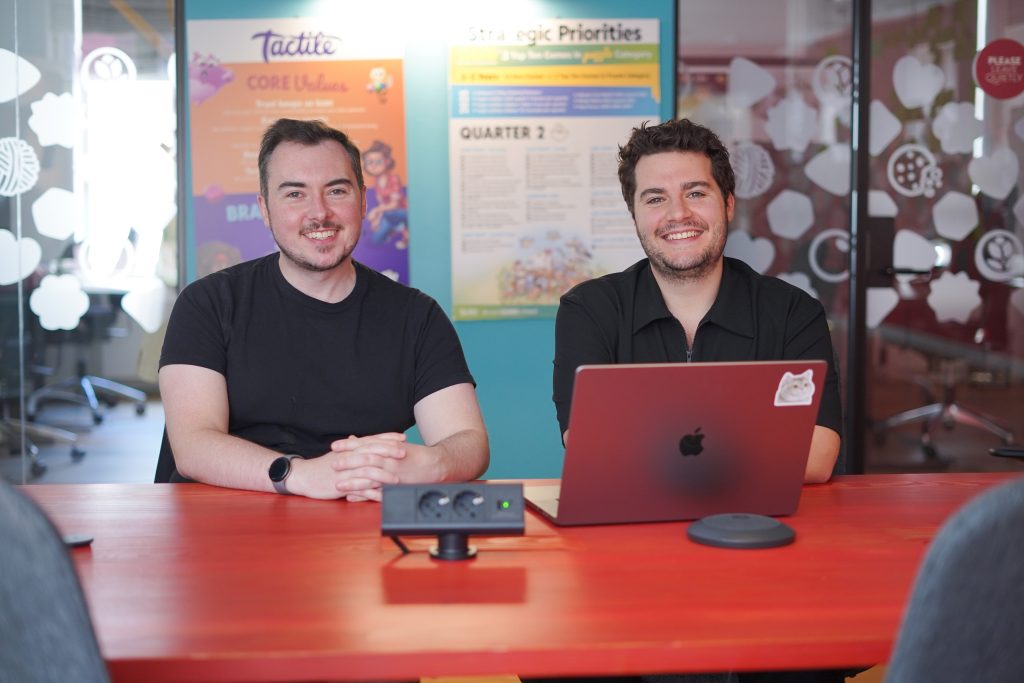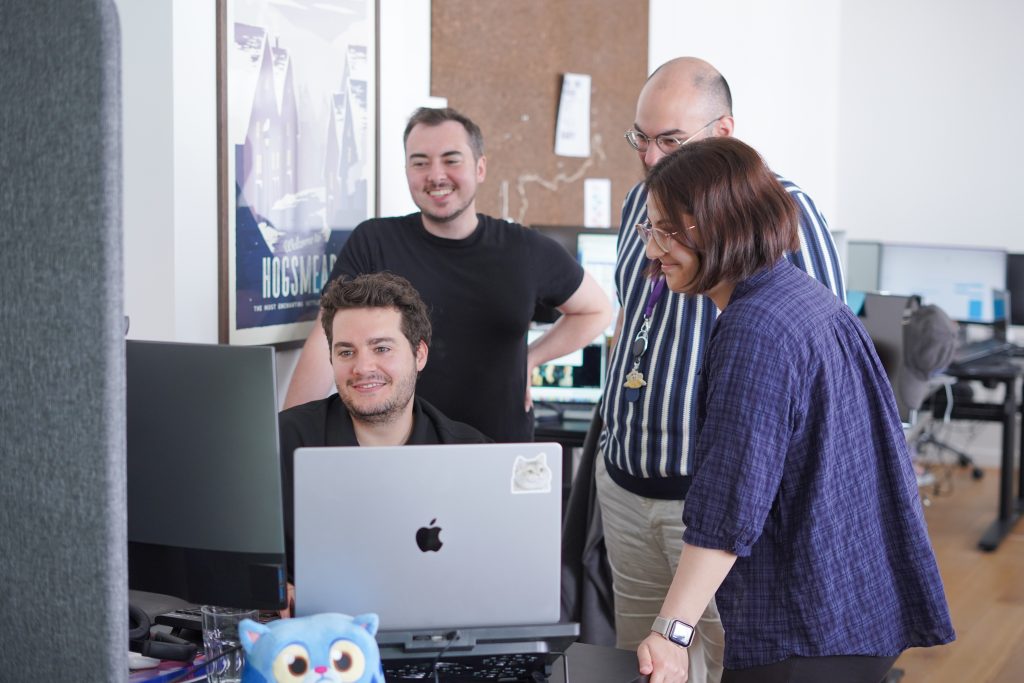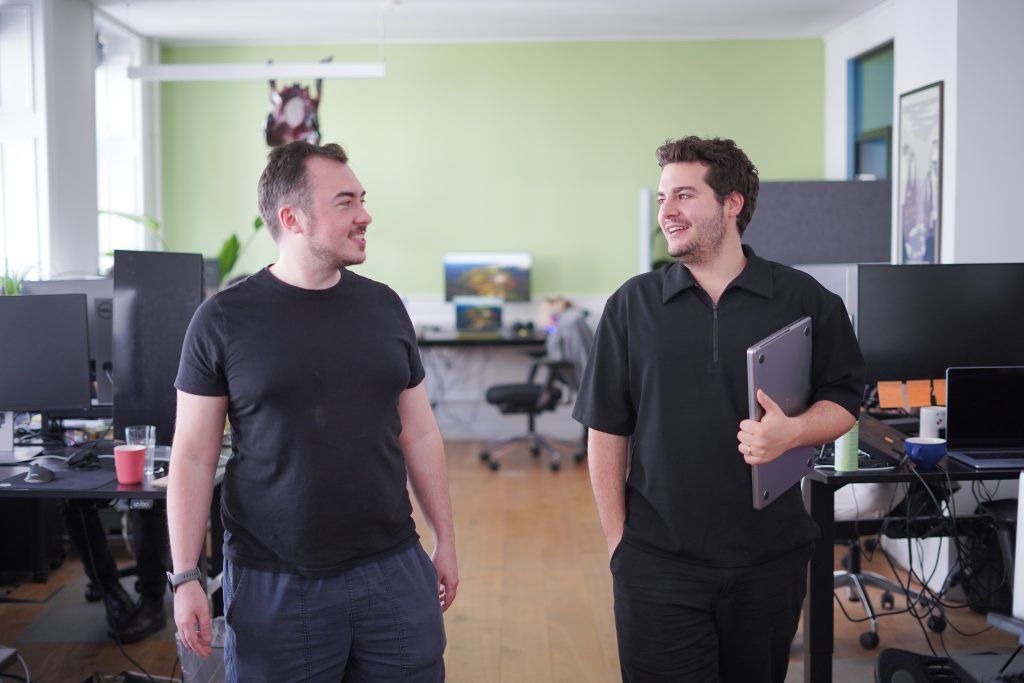In 2023, 3 years after the launch of Simon’s Cat: Story Time on Apple Arcade, we felt like it was time to start thinking about the next game. This time, we really wanted to push the boundaries of what we’ve done before and explore more options with this IP. Our UK team, who has been working in close collaboration with the Simon’s Cat team since 2017, started brainstorming new ideas. They looked at the market to understand what were the general trends and which games were doing well. At the same time, Simon sent some of his own concepts in, which helped set the framework for what would later become Simon’s Cat Match.
As a company, since the launch of Lily’s Garden in early 2019, we have been focusing predominantly on developing story-driven, landscape games. Exploring within the realm of Simon’s Cat IP, having previously developed blast, swap and pop games, has given us the opportunity to see whether we can develop a competitive game in the current match-3 market. Beyond that, it has enabled us to get back to our roots – the portrait mode style games with a light meta layer and a big focus on gameplay. This has also given us the opportunity to reach a wider player audience, as the match-3 genre has a more universal appeal.
To fully understand how we tackled the challenge of building a more gameplay focused match-3 game with the help of Simon’s Cat IP, we sat down with Luke, our UK studio’s Producer, and Ali, Simon’s Cat Match Product Lead.

Reigniting the spark
Bringing Simon’s Cat Match to life was truly a cross-studio collaboration. At the beginning, the UK team (based in Derby) kick-started the project and created the first version of the game. After running some technical tests, the results showed promising metrics. At the same time, after wrapping up their latest project, there was a team in Copenhagen ready for the next adventure. It was the perfect match! 😄🧩
The collaboration between the 2 studios started by working on improving version 1 of the game and prepping it for another technical test. Whilst the Derby team brought the knowledge of the IP to the table, the Copenhagen team brought the expertise and learnings from our older games, such as Lily’s Garden and Makeover Match.
Makeover Match (MM), in fact, served as the basis for this new Simon’s Cat game. When we started working on MM, we invested a significant amount of time into re-developing our core gameboard tech. The new tech enables us to do a lot more with our game board, including expanding our core gameplay mechanics. This is why we were able to take MM, flip it from landscape to portrait, and start building Simon’s Cat Match on top of it.
Making the game pawesome
The initial vision for the game hasn’t changed drastically throughout the development. Match-3 levels remained the main focus of the game, but over time, the game started to develop its own identity. As this is a young game, the team was able to move faster and make bolder changes.
When the game was in soft launch, they continued researching the market with the aim of improving the initial metrics. They found that there were games with ‘find the thing’ that were performing really well, but they were mainly in black and white. Since our in-game areas were in full colour, we decided to add the colouring aspect. This felt like a great match with the Simon’s Cat IP, both from the general artistic perspective, but also because it added the +1 innovation aspect to the game that would differentiate us from competitors. On top of that, ‘find the thing’ and colouring creatives were yielding great results in marketing.
And so it felt like the most natural decision to change the meta of the game and implement these two mechanics. The colouring part in particular fits well with the original Simon’s Cat YouTube series which were in black and white. “It feels like bringing Simon’s sketches to life,” says Luke Earle, the game’s Producer. “This has made Simon’s Cat Match the most on-IP game we have ever released.”
Once we had settled on the core gameplay and meta aspects of the game, it was time to dive into the nitty gritty details. From the start, the team incorporated special level types into the game, but they wanted to add even more diversity. They once again took a look at the general match-3 market, as well as what other in-house productions were working on.
Finally, after extensive testing and research, the team decided to add Garden Battle levels to the game. The general idea behind this special level type is that the player is playing against a villain in the game – this villain then calls his minions to the gameboard, which makes it more challenging for the player to complete the level. It’s not just about reaching the level goal with a limited amount of moves, but also about doing so before the villain has a chance to counter attack. Adding the Garden Battle levels has given the team a lot of freedom to try out new things, such as implement new game board pieces (which is important for user experience and engagement) and connect the game better with the narrative of the IP (in Simon’s Cat YouTube series storyline, there is a big rivalry between Cat and Jazz, who is also our in-game villain).
The benefits of having a strong track record
“Having worked on 3 Simon’s Cat games previously, we have spent a significant amount of time on polishing them, so there has been a huge evolution of our art and animation skills over time. This is now reflected in the visual quality of Simon’s Cat Match and is something we’re extremely proud of,” says Luke.
A lot of the know-how came from our work on Lily’s Garden. In the game’s meta layer, the art team has to create 3 versions of each prop, which the player can then choose from when making renovations. This means that over the years, the team really optimized the asset creation process. This allowed Simon’s Cat team to take and apply the knowledge to their own project.
On top of that, the UK team’s close collaboration with Simon and his team, as well as the connection with the team in Copenhagen and other studios working on the art assets, allowed for the creation of a really strong feedback process. “Discussing ideas quickly and brainstorming without having to go through extra layers of management has allowed us to make improvements faster. This is why the visual part became the strongest aspect of the game,” says Ali, Simon’s Cat Match Product lead. “Having a flatter structure within teams allows for everyone to share their opinions, regardless of their background, experience or seniority.”

Besides nurturing our flat structure, what’s helped us improve over the years has been growing our teams with skilled new Tactilers. This includes also expanding our leadership team with the addition of Norberto (Chief of Data & Analytics) and Jacob (CMO), who brought with them strong knowledge from the casual mobile gaming industry. These skilled people have helped us to elevate the quality of our products and have made a significant difference to our ways of working. A great example of such an addition to our team is Ali himself, who has brought with him the experience and knowledge from the Turkish gaming industry. These new talents, combined with the knowledge accumulated over many years by the more ‘seasoned’ Tactilers, has allowed us to reflect, learn, reuse and innovate better than ever before.
“There’s always the danger of everyone starting to think in a similar way when the same team spends a long time together,” explains Ali. “So getting people from other projects or even other studios is really helpful, as it allows for fresh perspectives.”
ONE team
Simon’s Cat Match was launched worldwide on March 26th 2025 🥳
Since then, the teams (in UK, Copenhagen, Argentina & Tenerife) continue to collaborate closely and continuously work on improving the connection between them. It is extremely important that no team works in a complete silo.
When asked about how they ensure strong links between teams, Luke explains: “As the Producer, it is key for me to plan our time well so that everyone can meet on a regular basis and hold conversations together. This is important in order for everyone to feel like a true part of the team, to understand our ways of working, the long-term vision, short-term goals, and is looped into all decision making processes.” This applies to art, game and level design, programming, QA, analytics and product – everyone is working together to achieve the desired goals.
Beyond this, open conversations and ad-hoc meetings are always encouraged. As the team is sitting across different locations, it’s important that team members are available on Slack or to jump on a quick call, to allow for the water-cooler conversations to translate into the digital space. Despite being in different locations, Simon’s Cat Match team is ONE team. “Everyone wants the project to succeed and so we never stop looking for ways to improve the product and the ways we work together,” adds Ali.

Ultimately it’s all about having the right people on the right project at the right time. Staying flexible within our roles allows us to allocate the right resources to new game projects. On top of that, everyone at Tactile is approachable and open to share knowledge from their own experiences, even if they’re not directly involved in a project. It’s all about being passionate about what we do.
“Everyone on the team loves playing match-3 games, which is crucial for me. It is extremely helpful as it creates a wider understanding of the market. When we discuss any aspect of the game, it’s important that people have informed opinions,” says Ali. When people love to play games and have plenty of experience in doing so, it enables the team to identify critical bugs in the game’s logic. It also allows us to go beyond just being game developers and to also apply the user experience perspective.
Luke wraps things up perfectly: “People are passionate about games. We are passionate about making games and we want to make the best games out there. That’s what we’re striving for and working towards. We want to play in the same field as the biggest game companies out there, but show them that success can also be achieved with smaller teams. And we want to be at the forefront of doing that.”
Simon’s Cat Match is just the first step. Stay tuned for more … Ahoy!
Copenhagen has become the world’s most liveable city according to the EIU’s Global Liveability Index 2025 👏
In light of this, we wanted to share a personal experience from one of our own – Aleksandra Bralczyk moved to Copenhagen from Warsaw, Poland in 2018.
This is her story 👇
When I moved to Denmark back in 2018, I didn’t really have any expectations. I just packed my things, booked a flight from Warsaw and went, all by myself. I didn’t have Copenhagen on my travel list nor on my list of countries I would like to move to. I think this is why the city made such an impression on me from the first day and that continues to this very day. I joke that my relationship with Denmark is a bit like a marriage – we made a mutual decision to be together knowing each other’s strengths and weaknesses. One of these strengths is definitely the working culture here.

⚒️ So, what’s it like to work in Denmark
Work constitutes 37 hours of our week and whilst we often say that perhaps a job doesn’t matter so much, this is still a lot of our time! Luckily, the work life balance in Denmark is very strong.
This is not a joke. Danes care deeply about their private life. I was shocked to see that almost none of my colleagues stayed at work past 5pm. In Poland, it tends to be quite normal to work after hours and generally take all your other commitments outside of the work hours. Here, in Denmark, your doctor appointments happen during the day and your colleagues will support you in that regard. 25 days of holiday and good parental leave policies are quite similar to both countries I lived in, but I can definitely see a lot of my international network appreciating how big the paid leave allowance is. There is also a lot of focus on resting – if you are on holiday, you don’t work. If you take a sick day, you are told to switch off.
👌 Trust is the group mind
The whole educational system in Poland focuses a lot on individuality, individual results and praise, and this kind of approach, of course, has its good sides. In contrast, in Denmark, both the schooling system and the workplace put a huge focus on how you cooperate as a part of the team. You will see people being very transparent, sharing knowledge with you and genuinely supporting your growth. As a person who loves sharing ideas with others I could never go back to the individualized way of thinking about my job.
🧑💼 Micromanagement is rare
The same goes for your manager and the leadership of your company. People leaders in Denmark aim at trust, collaboration and partnership. You will receive a lot of autonomy which can sometimes seem surprising! (Do they really trust me to do it, all by myself?!)
Your leads also expect you to come to them with your challenges and feedback, rather than micromanage and check on you every other hour.
You are the one to track your own results and progress, and they are there to help you and support you when you need them to jump in. Do not be afraid to challenge your lead. They will appreciate your opinion on things and this will not be treated as a lack of respect for their authority, as it might come across in other countries.
💰 The salaries are not “high” – they are equal
This is a point I really wanted to mention here as it often gets misunderstood. Denmark puts a lot of focus on equality. There is a common perception that salaries here (or in Scandinavia in general) are high. I don’t think that’s the way it works. The salaries here are well regulated and therefore the majority of people – no matter their profession – can afford a sustainable, good quality life. I only have the other perspective of Poland, where the compensation gap between the IT/tech sector compared to other fields is huge. That then leads to inequality which is of course for the benefit of the high earners, but perhaps not so much for the people working in other areas. I would say that all in all, moving to Denmark solely for the financial upgrade or gain does not make much sense – I would recommend it only if you are passionate about the country, culture and a great standard of life based on equality. The taxes are high but thanks to them you can enjoy many great investments, like a robust bicycle infrastructure, and not to mention the free healthcare and free education 🙌
✅ The system just works!
I must admit I was positively surprised (in my individual case) about how well the public healthcare system works. I haven’t had a chance to try this myself, but I can see from my network that there is also a big safety net for job seekers, which makes people go for jobs that actually make them happy. If one is affected by layoffs, there is quite a lot of resources to support them, including their union. The salaries are paid out for a longer period of time and if you have also insured yourself with the unemployment benefit, you can receive support for even longer. The education is free which makes it accessible for most and universities work a lot with employers to ensure employability after graduation. If you are a member of a union you can count on help in regards to, for example, reading your contract before you sign it, brainstorming about your offer or getting tips and tricks on how to plan a successful parental leave.
💗 It can be hard to make friends, but inclusion is important
It is true that it is hard to make friends in Denmark. There are more and more international groups and initiatives to be involved in though. Signing up for classes or activities is always a good idea. The one thing that I always appreciated besides that is that inclusion is very important. There are heaps of initiatives in terms of DEIB in Denmark. The good thing about people overall is the general feeling of safety that for me as a woman moving countries alone was extremely important. I feel safe on my commutes and at social gatherings and that means a lot!
♻️ Sustainability and the environment
Denmark is a global leader in sustainable development. The country invests heavily in renewable energy, green technologies, and environmental initiatives. You can feel it in your day to day. Companies recycle and try to cook green for their employees. There are a lot of ways in which as an employee you can feel like you’re contributing to saving the planet.
If you’re curious about learning more about life in Denmark, here’s a few more resources you can look through 👇
- On the Danish Welfare System
- Before Moving to Denmark
- Life in Denmark overview (before moving, during and after leaving)
- A guide to Copenhagen neighborhoods
It’s Time for Talent – with Kerstin Edin Stewart
Hi, my name is Kerstin, it’s nice to e-meet you! 👋
I joined Tactile at the end of the summer of 2023 as a Game-UI artist. I work on Lily’s Garden where I create art for new events, updating existing UI, and now game board pieces.
🌱 Before Tactile
I’ve always loved to make art, and – as a lifelong nerd – I’ve always loved video games, so becoming a Game Artist seemed like a perfect fit.
I studied at The Game Assembly (TGA) in Malmö and got an internship at King where I stayed for several years. I’ve worked for various game studios in Barcelona, London, and remotely.
💜 Joining Tactile
Since I joined, we’ve introduced Scrum, enabling cross-disciplinary collaboration. It’s been a great way to work more agile and gain a deeper understanding of how other departments operate. I’ve had the opportunity to be a part of several teams, which has helped me to connect with more colleagues and to begin mentoring and supporting other artists.
I recently returned from maternity leave as well, and Tactile has been incredibly supportive, both in organizing the leave and accommodating my requests for returning to work. It’s also genuinely a great place for parents, with a strong emphasis on family and a healthy work-life balance.
💪 Having an impact
My team is part of Lily’s Garden Game Board Art department, where we focus on crafting fun and engaging experiences for players interacting with the core gameplay. I’m especially motivated by the creative process of bringing new ideas, such as game pieces and events, through the entire development pipeline, from concept to implementation.
💡 What can you do at Tactile that you can’t do elsewhere?
At Tactile, we embrace an open and collaborative culture where anyone can talk to anyone. Roles are broad by design, allowing us to work across entire pipelines from start to finish. Within the art department, this means that we not only create assets, but also implement them ourselves, which ensures that they function as intended in the game.
📚 The keys to success
If you’re looking to get into the gaming industry, here’s some tips from my own experience.
In general: Embrace experimentation within (and possibly outside) your discipline, and venture beyond your familiar territory occasionally. Don’t hesitate to explore new possibilities. Numerous excellent game development schools exist. I recommend exploring options that include internships at actual game studios.
For Artists: At TGA I was often told to not have fanart or manga in my portfolio, I consistently did so despite being discouraged. My belief is that passion for a subject enhances the quality of artistic work, making it shine more brightly than work done solely to please others. Your art is ultimately for yourself.
I also want to add – if you have the opportunity, I highly recommend trying to work abroad. For some, it comes naturally; for others, it’s a challenge. Uprooting your life is never easy, but even a short time abroad can be a humbling and deeply rewarding experience.
